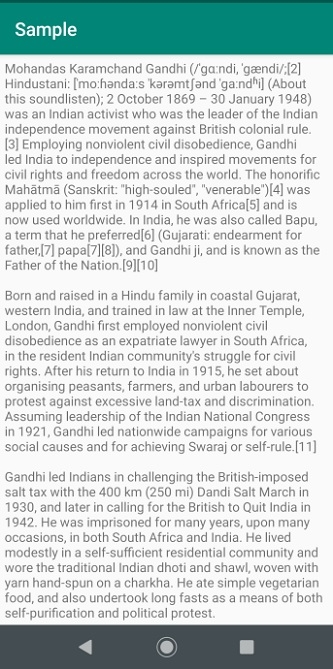如何在 Android 應用程式中建立可滾動文字檢視?
該示例展示瞭如何在 Android 應用程式中建立可滾動的文字檢視。
步驟 1 - 在 Android Studio 中建立一個新專案,轉到檔案 ⭢ 新建專案,然後填寫所有必需資訊以建立一個新專案。
步驟 2 - 向 res/layout/activity_main.xml 中新增以下程式碼。
<?xml version="1.0" encoding="utf-8"?> <RelativeLayout xmlns:android="http://schemas.android.com/apk/res/android" xmlns:tools="http://schemas.android.com/tools" android:id="@+id/activity_main" android:layout_width="match_parent" android:layout_height="match_parent" android:padding="5dp" tools:context=".MainActivity"> <TextView android:id="@+id/textView" android:layout_width="wrap_content" android:layout_height="match_parent" android:scrollbars="vertical" /> </RelativeLayout>
步驟 3 - 向 src/MainActivity.java 中新增以下程式碼
package app.com.sample;
import android.support.v7.app.AppCompatActivity;
import android.os.Bundle;
import android.text.method.ScrollingMovementMethod;
import android.widget.TextView;
public class MainActivity extends AppCompatActivity {
@Override
protected void onCreate(Bundle savedInstanceState) {
super.onCreate(savedInstanceState);
setContentView(R.layout.activity_main);
TextView textView = (TextView) findViewById(R.id.textView);
String para = "Mohandas Karamchand Gandhi (/ˈɡɑːndi, ˈɡændi/;[2] Hindustani: [ˈmoːɦəndaːs ˈkərəmtʃənd ˈɡaːndʱi] (About this soundlisten);
2 October 1869 – 30 January 1948) was an Indian activist who was the leader of the Indian independence movement against British colonial rule.[3]
Employing nonviolent civil disobedience, Gandhi led India to independence and inspired movements for civil rights and freedom across the world.
The honorific Mahātmā (Sanskrit: \"high-souled\", \"venerable\")[4] was applied to him first in 1914 in South Africa[5] and is now used worldwide.
In India, he was also called Bapu, a term that he preferred[6] (Gujarati: endearment for father,[7] papa[7][8]), and Gandhi ji, and is known as the Father of the
Nation.[9][10]
" + "
" + "Born and raised in a Hindu family in coastal Gujarat, western India, and trained in law at the Inner Temple, London, Gandhi first
employed nonviolent civil disobedience as an expatriate lawyer in South Africa, in the resident Indian community's struggle for civil rights. After his return
to India in 1915, he set about organising peasants, farmers, and urban labourers to protest against excessive land-tax and discrimination.
Assuming leadership of the Indian National Congress in 1921, Gandhi led nationwide campaigns for various social causes and for achieving Swaraj or
self-rule.[11]
" + "
" + "Gandhi led Indians in challenging the British-imposed salt tax with the 400 km (250 mi) Dandi Salt March in 1930, and
later in calling for the British to Quit India in 1942. He was imprisoned for many years, upon many occasions, in both South Africa and India.
He lived modestly in a self-sufficient residential community and wore the traditional Indian dhoti
and shawl, woven with yarn hand-spun on a charkha. He ate simple vegetarian food, and also undertook long fasts as a means of both
self-purification and political protest.
" + "
" + "Gandhi's vision of an independent India based on religious pluralism was challenged in
the early 1940s by a new Muslim nationalism which was demanding a separate Muslim homeland carved out of India.[12] In August 1947, Britain
granted independence, but the British Indian Empire[12] was partitioned into two dominions, a Hindu-majority India and Muslim-majority Pakistan.[13]
As many displaced Hindus, Muslims, and Sikhs made their way to their new lands, religious violence broke out, especially in the Punjab and Bengal.
Eschewing the official celebration of independence in Delhi, Gandhi visited the affected areas, attempting to provide solace. In the months following,
he undertook several fasts unto death to stop religious violence. The last of these, undertaken on 12 January 1948 when he was 78,[14] also had
the indirect goal of pressuring India to pay out some cash assets owed to Pakistan.[14] Some Indians thought Gandhi was too accommodating.[14][15]
Among them was Nathuram Godse, a Hindu nationalist, who assassinated Gandhi on 30 January 1948 by firing three bullets into his chest.[15";
textView.setText(para);
textView.setMovementMethod(newScrollingMovementMethod());
}步驟 4 - 向 androidManifest.xml 中新增以下程式碼
<?xml version="1.0" encoding="utf-8"?> <manifest xmlns:android="http://schemas.android.com/apk/res/android" package="app.com.sample"> <application android:allowBackup="true" android:icon="@mipmap/ic_launcher" android:label="@string/app_name" android:roundIcon="@mipmap/ic_launcher_round" android:supportsRtl="true" android:theme="@style/AppTheme"> <activity android:name=".MainActivity"> <intent-filter> <action android:name="android.intent.action.MAIN" /> <category android:name="android.intent.category.LAUNCHER" /> </intent-filter> </activity> </application> </manifest>
讓我們嘗試執行您的應用程式。我認為您已經將您的 Android 移動裝置連線到了您的計算機。要從 Android Studio 中執行該應用程式,開啟您的某個專案活動檔案,然後單擊工具欄中的執行 ![]() 圖示。選擇您的移動裝置作為選項,然後檢查將顯示您的預設螢幕的移動裝置 -
圖示。選擇您的移動裝置作為選項,然後檢查將顯示您的預設螢幕的移動裝置 -

單擊 此處 下載專案程式碼。

廣告

 資料結構
資料結構 網路
網路 RDBMS
RDBMS 作業系統
作業系統 Java
Java iOS
iOS HTML
HTML CSS
CSS 安卓
安卓 Python
Python C 語言程式設計
C 語言程式設計 C++
C++ C#
C# MongoDB
MongoDB MySQL
MySQL Javascript
Javascript PHP
PHP